Stay Informed
Popular Articles
- Hiatal Hernia: Hidden Cause of Chronic Illness
- Small Intestinal Bacterial Overgrowth (SIBO)
- Applied Lymphology: Unlocking the Secret to Pain Relief
- An Introduction to Constitutional Iridology
- The Low Down on Liver Detoxification
- An Energetic and Emotional Approach to Cancer
- Fat Facts
- Marrow in the Bones
- Blood Type and Nutrition
- Cardiac Herbs: Beyond Hawthorn
Quick Search
The School of Modern Herbal Medicine




Omega-3 Essential Fatty Acids
- 7/16/2008
- Categorized in: Nutrition
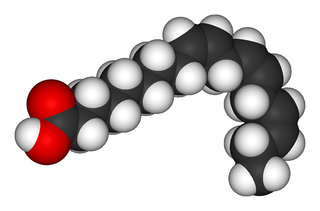 This is part four of a four-part article.
This is part four of a four-part article.
The basic Omega-3 EFA is linolenic acid. Most Americans get too much Omega-6 EFA (linoleic acid) and too little of this Omega-3 essential fatty acid. The principle form of Omega-3, alpha linolenic acid (ALA), which is shown on the right, will convert into eicosapentaenoic acid (EPA), and then into docosahexaenoic acid (DHA) in a healthy body. EPA in combination with GLA (from Omega-6) is used to make eicosanoids that mediate inflammation, improve immune response and otherwise promote good health. Without the EPA from Omega-6 the EPA tends to be converted to eicosanoids that lower immune response, increase inflammation, raise blood pressure and have other undesirable effects.
Deficiencies of Omega-3 EFA have been linked to decreased mental abilities, loss of memory, learning disabilities like ADHD, PMS problems, tingling sensations in the nerves, poor vision, the increased tendency to form blood clots, reduced immune activity, high blood pressure, an increase in inflammatory disorders like arthritis, and cardiovascular disease. Since the vast majority of North Americans are deficient in Omega-3 EFA this provides a clue as to why these health problems are so common.
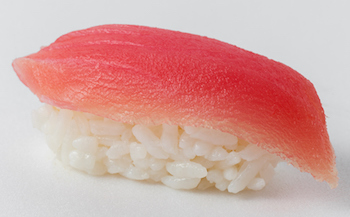 Omega-3 is found in flaxseed oil, flaxseeds, hemp seeds, walnuts, pumpkin seeds, Brazil nuts, sesame seeds, avocados, some dark green leafy vegetables (kale, mustard greens, collard greens, etc.), deep ocean fish (mackerel, sardines, anchovies, albacore tuna, etc.) and wild salmon (but not farm-raised salmon).
Omega-3 is found in flaxseed oil, flaxseeds, hemp seeds, walnuts, pumpkin seeds, Brazil nuts, sesame seeds, avocados, some dark green leafy vegetables (kale, mustard greens, collard greens, etc.), deep ocean fish (mackerel, sardines, anchovies, albacore tuna, etc.) and wild salmon (but not farm-raised salmon).
By way of review, remember that all essential fatty acids are polyunsaturated, which means they have more than one pair of double bonds. If you'll recall the shopping bag analogy we've been using, this means that more than two pairs of carbon atom “shoppers” are holding hands with each other instead of holding onto a hydrogen molecule “shopping bag.”
These long changes of carbon molecules have two ends—an omega end and a delta end. What determines whether the fatty acid is an Omega-6 or an Omega-3 fatty acid is the location of the first double bond, that is, how may carbon molecules away from the omega end of the fatty acid do we find the first double bond. An example of an Omega-3 fatty acid chain is shown below.

The reason Omega-3 and Omega-6 fatty acids are essential to the body is because the body is capable of adding more double bonds farther down the line, but can't add them closer to the omega end. One of the primary uses for these essential fatty acids is to make eicosanoids, chemical messengers used by every cell of the body. Making these eicosanoids requires lengthening the carbon molecule chains from 18 to 22 carbon molecules long, and desatrurating them (i.e., removing more hydrogen atoms).
These eicosanoids are the most primitive of all hormones—autocrine hormones. These autocrine hormones are released into the fluids surrounding the cells and rapidly taken up by neighboring cells. Because they last only a few seconds, they have only recently come to the attention of scientists. These eicosanoids or autocrine hormones include: prostaglandins, leukotrienes, lipoxins, thromboxanes and cyclooxygenases (COX-1 and COX-2).
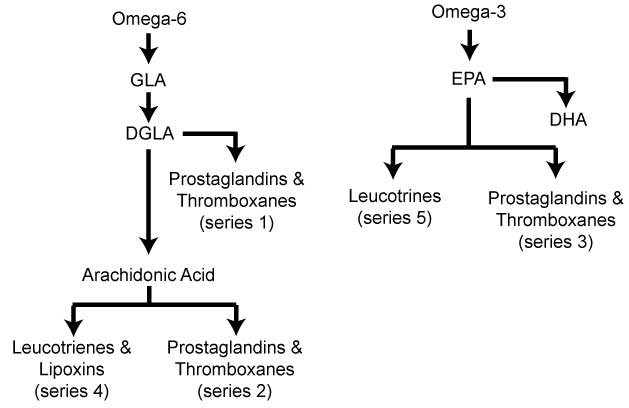
The chart above shows how the body converts Omega-6 and Omega-3 fatty acids into these messengers. Ideally, there should be a ratio of about 1:1 to 4:1 between Omega-6 and Omega-3. That means for every “dose” of Omega-3 essential fatty acids we should be getting one to four “doses” of Omega-6. Unfortunately, the average person is getting a ratio of between 10:1 and 25:1. That's not good, and here's why.
As shown in the chart, Omega-6 (linoleic acid) is converted to GLA. This is done by an enzyme which removes 2 hydrogen atoms. This creates GLA (gamma linoleic acid). Another enzyme adds 2 more carbon molecules to the chain. Using our analogy, it lets two more carbon molecule “shoppers” butt into the line. This creates DGLA (dihomo-gamma linoleic acid).
Now, here's where Omega-3 becomes important. DGLA normally prefers to be converted into series 1 prostaglandins and thromboxanes. These are good guys, reducing inflammation and keeping us healthy. However, an enzyme called delta-5-desaturase can covert DGLA to arachodonic acid (AA). We don't want that to happen, because then eicosanoids, which will increase inflammation and have other harmful effects, will be produced instead.
Delta-5-desaturase is the same enzyme that converts Omega-3 to EPA (eicosapentanoic acid), which is a good thing. However, if it doesn't have enough Omega-3, it gets bored with having nothing to do and starts converting DGLA to AA. So, to keep our DGLA on the “strait and narrow” we need to have ample amounts of Omega-3 to keep it busy.
Supplementing Omega-3
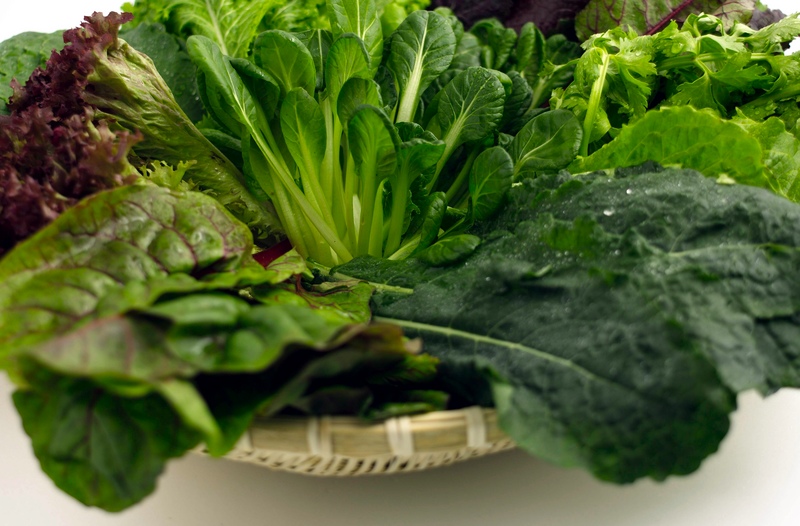 So, where do we get Omega-3? It's found primarily in green leaves. That's right, Omega-3 is in those dark green leafy vegetables all of us are supposed to be eating (but few of us are). This is why just about everyone needs to supplement their diet with Omega-3 and the best way to do that is with flax seeds and flax seed oil.
So, where do we get Omega-3? It's found primarily in green leaves. That's right, Omega-3 is in those dark green leafy vegetables all of us are supposed to be eating (but few of us are). This is why just about everyone needs to supplement their diet with Omega-3 and the best way to do that is with flax seeds and flax seed oil.
Flax seed has an ideal ratio of Omega-6 and Omega-3, so it will ensure that you are getting the fatty acids you need. Because it is polyunsaturated, it isn't very shelf stable and goes rancid very easily. So, you need to keep it refrigerated and take it raw. However, some people lack the enzymes to be able to convert the ALA in flax seed oil into the longer forms like DHA and EPA. So, flax seed oil may not work for some people. It also goes rancid quickly.
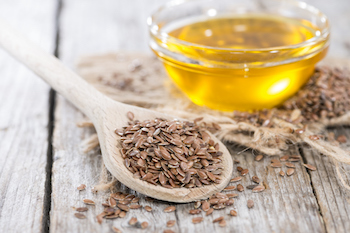 Just one tablespoon of flax seed oil will provide the minimum requirement of both Omega-6 and Omega-3 for an adult. Of course, you could swallow this in gel caps (but that's a lot of gel caps). You can also take it straight if you like swallowing spoonfuls of oil (don't knock it—a lot of children do). As for me, I prefer to incorporate the oil into my food.
Just one tablespoon of flax seed oil will provide the minimum requirement of both Omega-6 and Omega-3 for an adult. Of course, you could swallow this in gel caps (but that's a lot of gel caps). You can also take it straight if you like swallowing spoonfuls of oil (don't knock it—a lot of children do). As for me, I prefer to incorporate the oil into my food.
For instance, I let butter sit in a dish until it reaches room temperature and then I blend it with flax seed oil to make soft spread butter. You can use anywhere from 1/2 to 1 cup of flaxseed oil per cup of butter (depending on how soft you want the spread to be). The flavor of this soft spread butter is great!
You can also use flax seed oil to make salad dressings, or in place of olive oil in hummus or other foods that aren't cooked. Flax seed oil can be mixed half and half with real maple syrup to use over pancakes and waffles (look Ma, no butter!). You can also use it straight on baked potatoes or in place of butter in your oatmeal.
Deficiencies of Omega-3 EFA have been directly linked to decreased mental abilities, loss of memory, learning disabilities like ADHD, PMS problems, tingling sensations in the nerves, poor vision, the increased tendency to form blood clots, reduced immune activity, high blood pressure, an increase in inflammatory disorders like arthritis and cardiovascular disease. On the other hand, daily supplementation with flax seed oil may help prevent the following problems: dry skin, cellulite, constipation, colitis, ulcers, hypoglycemia, diabetes, heart disease, high cholesterol, calcium deficiencies and reproductive and immune system problems.
Wow, what a difference adding a little of the right kind of oil makes in people's health! Maybe we should start promoting flax seed oil as lubrication for the wheels of health. Of course, it wouldn't hurt to eat those green leafy veggies, either.
Fish Oils
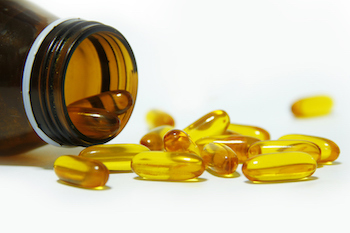 Now, what about fish oils? Aren't fish supposed to be great sources of Omega-3? Yes, they are, but you want to make sure that the oils are distilled to remove ocean contaminents. Omega-3 supplements are actually very useful for many people, especially people with any kind of chronic inflammatory condition. They are also helpful for reducing your risk of heart disease. If you have problems burbing up the oil when you take them, try freezing them first. When you swallow the frozen capsules this won't happen.
Now, what about fish oils? Aren't fish supposed to be great sources of Omega-3? Yes, they are, but you want to make sure that the oils are distilled to remove ocean contaminents. Omega-3 supplements are actually very useful for many people, especially people with any kind of chronic inflammatory condition. They are also helpful for reducing your risk of heart disease. If you have problems burbing up the oil when you take them, try freezing them first. When you swallow the frozen capsules this won't happen.
Actually, any wild animal or deep ocean fish is going to have a reasonable amount of Omega-3 fatty acids. However, the amount of Omega-3 in any animal food depends on how much Omega-3 is in its diet, since animals can't make Omega-3 any more than we can. That's why farm-raised salmon and non-grazing animals can be deficient in Omega-3, too.
When I raised chickens and gathered my own eggs, I used to marvel at the deep orange color of the yolks. I now know that this is partly due to a higher content of Omega-3 fatty acids in my free ranging chickens (because of the greens they were eating while scratching around the yard). If you buy eggs from hens that are fed flax seeds, the yolks are darker (and taste better) too.
Other Sources of Omega-3
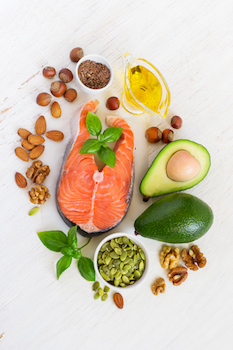 Omega-3 is also found in hemp seeds, walnuts, pumpkin seeds, Brazil nuts, sesame seeds and avocados. Now, as for the deep ocean fish (and the fish oil supplements like Super Omega-3 EPA) they don't actually contain that much linolenic acid (your basic Omega-3 fatty acid). What they do contain is more of the fatty acids our body converts Omega-3 into, i.e., EPA and DHA. That's because animals, including fish, make these same conversions.
Omega-3 is also found in hemp seeds, walnuts, pumpkin seeds, Brazil nuts, sesame seeds and avocados. Now, as for the deep ocean fish (and the fish oil supplements like Super Omega-3 EPA) they don't actually contain that much linolenic acid (your basic Omega-3 fatty acid). What they do contain is more of the fatty acids our body converts Omega-3 into, i.e., EPA and DHA. That's because animals, including fish, make these same conversions.
Just like our ability to convert Omega-6 (linoleic acid) into GLA and DGLA can be inhibited by poor nutrition, so can our ability to convert Omega-3 (linolenic acid) into EPA and DHA. This is because the same enzymes are involved. It works like this.
Both linoleic and linolenic acid are 18 carbon molecules long. In each case, the body starts by using the delta-6-desaturase (a desaturating enzyme) to remove 2 hydrogen molecules from the fatty acid making the fat less saturated. In other words, it takes two shopping bags away from the shoppers.
Next, elongase adds two more carbon molecules to the chain, so that the chains are now 20 instead of 18 molecules long. (E-long-ase, get it? See chemistry doesn't have to be that mystical.) Using our analogy, it helps two more shoppers butt into the line.
Alcohol, diabetes, deficiencies of B6, magnesium, zinc and excess saturated fats and transfatty acids will all inhibit these enzymes.
Delta-5-desaturase, which is involved in creating EPA, is inhibited by deficiencies of vitamin C, niacin and zinc.
By the way, eicosanoids are 22 carbon molecules long, so the final conversion of essential fatty acids to these chemical messengers requires two more shoppers to butt into line. (So, if these carbon molecules were really shoppers, they'd be really ticked at this point. Fortunately, it's only an analogy.)
I hope this article has helped you better understand the nature of fatty acids.
